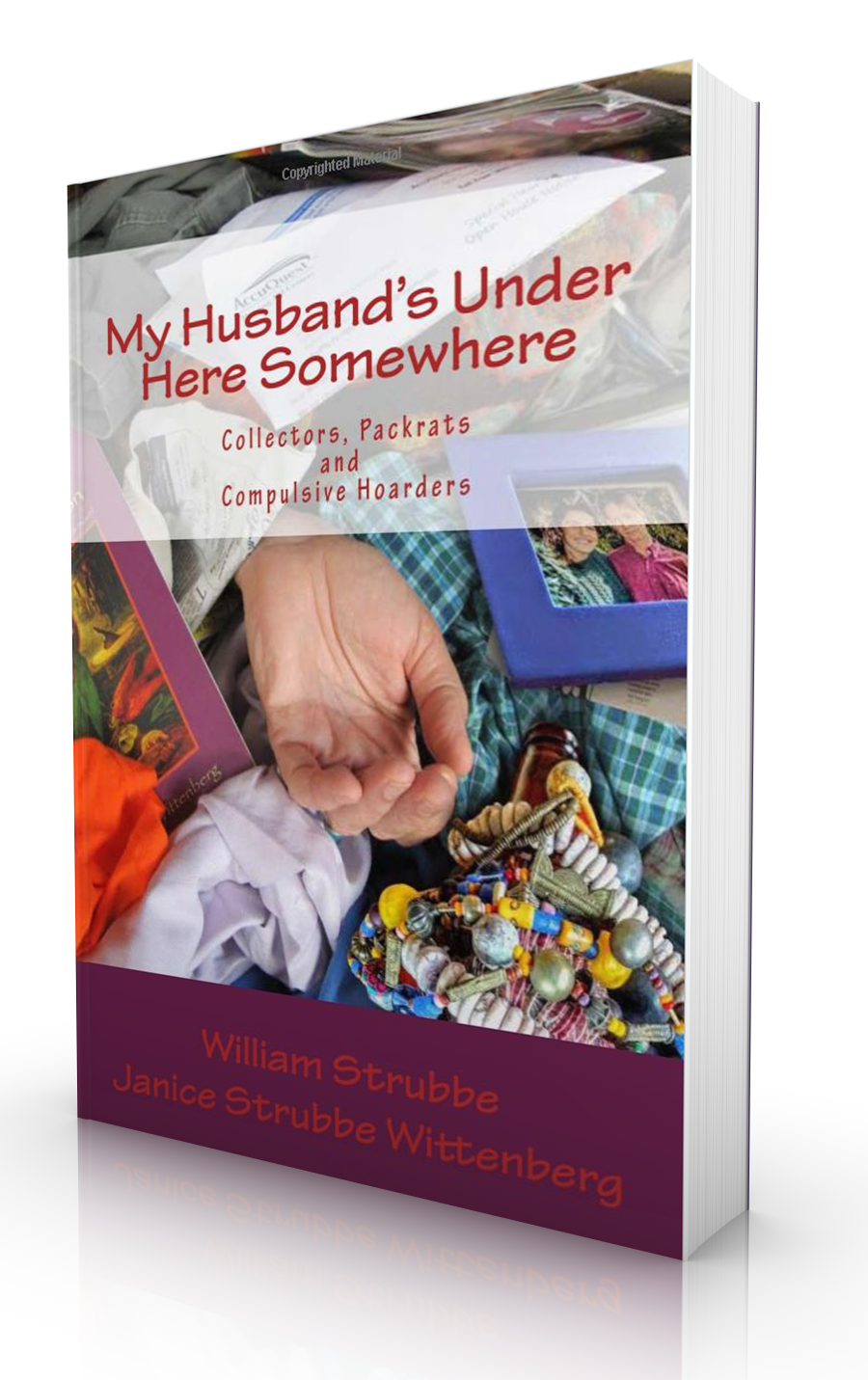Sample Chapter
Introduction: What a Dump!–To Have and to Hold Ever More
“Trying to be happy by accumulating possessions is like trying to satisfy hunger by taping sandwiches all over your body.”—George Carlin.
The red T-shirt I usually wore on the job read, “Obey Me.” And one time, I facetiously returned to a recalcitrant client’s home flailing a cat-o-nine-tails. Yet, those whips and paddles in my arsenal were more figurative than literal, as I already held the upper hand.
A potential client dialing up Clutter Busters had already traversed the critical boundary to acknowledge their helplessness in the face of their amassed junk and clutter to seek my authoritative cattle-prod. Willing to pay a professional organizer to help deconstruct their chaos, they actually tolerated my bossiness.
Given the operative words, Obey Me, my clients usually did. Although I joked around and tried to make the process fun, I could be unflinchingly strict when necessary.
Whereas mild collectors simply needed my assistance to clean out their garage, or to arrange a home office, or to sort through possessions after the death of a spouse, others were truly desperate. One gentleman shoved a dresser in front of a bursting closet to keep it shut; another rented parking space because he’d crammed his garage so full of newspapers and garbage that no car, nor even another twig could fit; another’s husband gave her an ultimatum—her stuff or him.
Tellingly, she chose her stuff!
Early on in my clutter-busting career, it dawned on me that these worst-cases weren’t just caused by lazy bums, but that something beyond run-of-the-mill human behavior was at play. So I should have been forewarned when one prospective client asked by phone if I had a pickup truck. Later, when the door opened to his San Francisco flat, as if something dead lay waiting, the stench bowled me over.
Quickly recovered, I managed to summon my best Bette Davis voice to remark, “What a dump!”—It literally was!
Until one experiences a house like this, it’s easy to deem my account more fiction than fact. Yet this five-room Victorian was only accessible via narrow trails that blazed through waist-high accumulations of garbage. The bed had disappeared beneath drifts of clothes, Books, newspapers, and various unimaginable items further filled the room. In the kitchen, dishes, pots, and pans, encrusted with blackened crud, were jammed in the sink. Food and other items spilled onto all countertops, and covered the floor, as well.
Abruptly, a furry creature scampered, then disappeared beneath a pile of rubble; I let out a squeak and shuddered. And the bathroom: well, I’ll skip the details…
Turning to my prospective client, who perched atop what seemed to be a couch arm that jutted out from the junk, I blurted, “Really…just a pickup truck? I need a dump truck and bulldozer to excavate this!”
The man blithely inquired, “Can you do it by Friday? My landlord’s going to evict me unless it’s all taken away.”
When asked how he planned to pay me, he did this majestic arm sweep, then replied, “I figured there’d be things you’d want in trade.”
Thinking I might’ve overlooked some fabulous treasure, as I scanned the room, it hit: This fellow wasn’t the typical run-of-the-mill slob, someone with an aversion to the garbage pail. To his mind, ALL his stuff held value.
Annoyance waning, I wished him good luck, and departed. With the stench still lingering in my clothes and hair; I couldn’t wait to get home to shower.
⌂⌂ ⌂
Who doesn’t know someone—a kooky cousin, a dear friend, a reclusive neighbor, or, heaven forbid, a beloved spouse—who dwells in a purgatory of clutter, risking eviction, as well as ostracism, to say nothing of facing legal battles—all for the sake of their junk. These unfortunate souls, beset with the irresistible urge to fill their homes, garages, yards, and storage-after-storage space with infinite amounts of seemingly useless gewgaws are locked into an immense struggle.
While the public-at-large may deem them lazy, wacko, confused, or terminally indecisive, the extreme hoarder is in the throes of a diagnosable illness and cannot help him or herself. These people cannot throw anything away, even if their well-being and life depend on it. In extreme cases, as John Gillette, M.D., staff psychiatrist with Santa Cruz County Mental Health can attest, it may boil down to precisely this: “Obsessive-compulsive hoarding is a confounding disorder that’s difficult to treat, and in severe cases, can be life-threatening.”
Scavenger, clutterer, packrat, and junkaholic are kindred terms for the word, hoarder, but the clinical appellation, obsessive-compulsive hoarder, fills a relatively new niche in psychiatric circles. With the 2013 release of the DSM-5—the Diagnostic and Statistical Manual of Mental Disorders, which is the venerated diagnostic standard used by mental health professionals—hoarding was first classified as a disorder unto itself. Yet hoarding as a mental health disorder remains little understood and has the dubious distinction of being the most challenging of the obsessive-compulsive spectrum disorders to treat.
⌂⌂ ⌂
Studies conducted by hoarding expert Randy Frost, Ph. D., along with another performed by the National Institute of Mental Health, estimate that between 2% and 3% of the U.S. population suffers from an obsessive-compulsive disorder (OCD). Though several other types of hoarding exist, most appear to be a subset of OCD, with about 15% to 30% of OCD sufferers—roughly 2 million Americans—who experience hoarding as their primary symptom. As awareness regarding the nature and complexity of this problem grows, these numbers will likely increase.¹,²
Hoarders can be divided into two subgroups: generalists and specialists. Generalists collect any object known to humankind. They tend to acquire household items, clothes, trash, or freebies, along with readily available materials, including newspapers, junk mail, receipts, and magazines.
My first encounter with a hoarder was a generalist who also collected animals. Jean, a friend of my mother’s, was intelligent, educated, and elegantly attractive. Despite many positives, however, love seemed to elude her. Eventually, I grasped why; a prospective suitor setting foot in her home no doubt got an eyeful and never returned.
Given all the clutter underfoot, it was tricky to walk about inside and her stairs were a hazard to climb. Her bed, covered with clothes, papers, dishes, books, and memorabilia, afforded little space to recline, which meant she slept upright in a chair alongside it.
Status as an unrepentant hoarder notwithstanding, her life’s mission, although admirable, involved the rescue of stray and unwanted animals. Any given week, five or six caged dogs barked and pooped in the kitchen, and dozens of cats swept through the house in a feline tide.
Unbearable stench aside, the most impressive feature in her living room were the myriad careening stacks of newspapers and magazines that covered all floors, tables, couches, and chairs. When I summoned nerve to inquire why she kept all of it, she replied, “Someday, I plan to clip articles of interest.”
It bears note that hoarders always intend at some future date to attend to their treasures. Yet that day never arrives.
“I stack papers atop furniture,” she added, “to keep the cats from urinating on the upholstery.”
My inquisitive self had to ask why one hideously stinky armchair remained unobstructed. To which she replied: “Ah, that’s so my cats have a place to pee.”
Thankfully, we retired to the porch for fresh air and refreshments.
The specialist accumulates one type, or a specific category of items. This may include mountains of books and printed materials; or boxes, overflowing with electronic devices; or even a particular type of animal; Manx cats, rare birds, rabbits or horses, for example. Vintage autos give some a thrill. Others have a penchant for moldy vintage clothes. One hoarder’s treasure consisted of the 46-year accumulation of soap remnants. Another odd one: Daniel’s passion was lint.
How Daniel’s attention riveted to lint, and what the appeal, eludes. Strands of thread and fluffballs peeked out from beneath his sofa and mattress, while other threads and filaments spilt from drawers and cupboards, and he constantly twined fluffy balls together.
Needless-to-say, he adored laundromats!
Then there’s Norman. Gums denuded of teeth, this guy was the sweetest man ever. Back when McDonald’s offered those colorful boxes for their Happy Meal burgers, he developed such an affinity for them that they filled his entire home, which prompted his wife of twenty-six years to give him the boot.
In the extreme, hoarding can be associated with psychosis, brain damage, or mental retardation. Billionaire playboy Howard Hughes saved his fingernail and toenail clippings. Some treasure hair or skin flakes, as well. One elderly woman and her grown son, using a spare bedroom as their lavatory, accumulated years of fecal material. A former suffragette and poet aggregated her urine in murky gallon bottles; another kept poop in Tupperware containers; another fellow shat in his socks, then tidily returned them to dresser drawers.
⌂⌂ ⌂
As the hoarder ages, he or she faces an escalating series of stressors—loss of control over bodily functions, the onslaught of illness, poor or limited finances, estrangement from self or from family, retirement, death of a spouse, social isolation, as well as the diminished ability to care for oneself. When such downturns occur, hoarding may escalate. A possible reason for this: the pastime may help create an imaginary line of defense against numerous losses.
Rather than relinquish independence and surrender to the organizing services provided by retirement communities or convalescent facilities, increased numbers of Baby Boomers opt to remain in their homes. This decision to “age in place” prompts experts to predict a marked increase in the prevalence of hoarding—in particular, dementia-related hoarding.
“The average age for those with hoarding problems is about fifty, yet many are older,” notes Gail Steketee, Professor at Boston University. “There’s a growing concern on the part of elder service workers about hoarding and how to manage its potential consequences, including fire and health hazards, risk of falling, and the inability to find medications.”
Thankfully, public awareness regarding hoarding, as it relates to obsessive-compulsive disorders, is on the rise. Hoarders and hoarding have become a topic of cult fascination, as millions obsessively follow the television shows Hoarders, Hoarding: Buried Alive, and Animal Planet’s Confessions: Animal Hoarding. While many watch such programs to be entertained or to be grossed out, few can fathom how it actually is to live like that.
A glimpse is offered with regard to this by Sally Fields, who stars in the film, Hello, My Name is Doris, about an emotionally stunted older woman with a tendency to hoard. Years ahead of its time, there was also the televised series Monk. The detective in the show is beset with tics and compulsions—which are OCD behaviors—and his agoraphobic brother, played by John Turturro, hoards junk.
⌂⌂ ⌂
Indeed, hoarding is often a family affair!
As I embarked on my odyssey to try to understand this phenomenon, as well as the folks impacted by it, I enlisted the expertise of my sister, Janice Strubbe Wittenberg. With over thirty-five years spent as a mental health nurse, seventeen of them as Santa Cruz County’s sole crisis outreach worker, she’s encountered many a hoarder.
Initially, I chalked up her fascinatingly peculiar tales about them as embellishment, but later apologized for doubting her. Many of her experiences working with these people are conveyed on these pages.
All incidents described in this book are based on the authors’ experiences, but in the interest of clarity, William’s contributions are written in the first person, while Janice is identified by name when she gives input.
Although one individual who suffers from this disorder urged, “Please go ahead, it’s important to tell our stories,” there’s a delicate balance between what can and cannot be said. To protect privacy—with the exception of certain professionals, along with the mention of real-life news stories—all names of clients and their families are changed. Additionally, each case described, including identifying details, is altered, fictionalized, and composited, to further render those involved unrecognizable.
While we hope to increase understanding as to this nightmarish problem, we don’t envision this to be a self-help book. By no means is the material herein exhaustive, and it shouldn’t pose as a substitute for seeking professional involvement.
We intend this work of lively observation and musing to prompt contemplation of one’s own acquisitiveness and excess. In this process, it may become clear to the reader that they participate in, contribute to, or add to this mess, precisely as the hoarder does, or that they do so to a lesser extent, or perhaps not at all.




Connect With Janice!